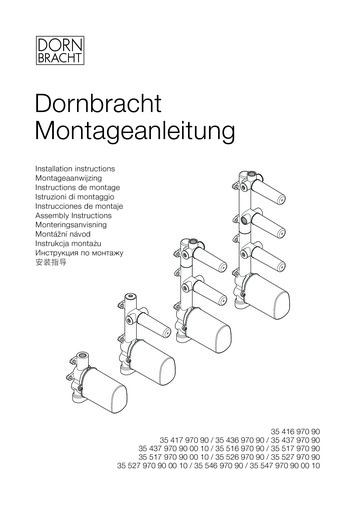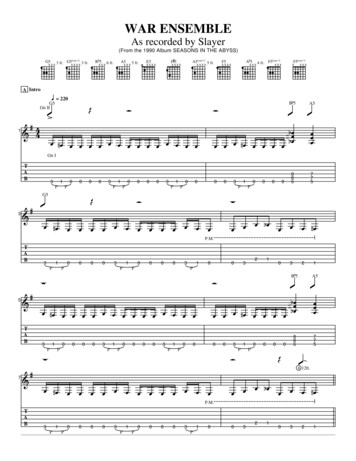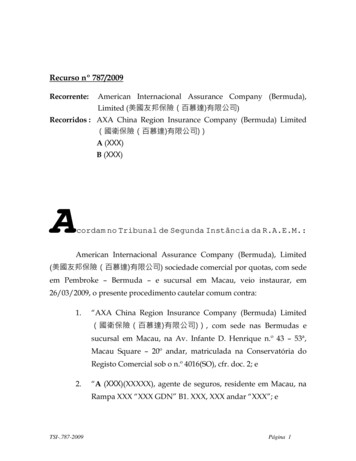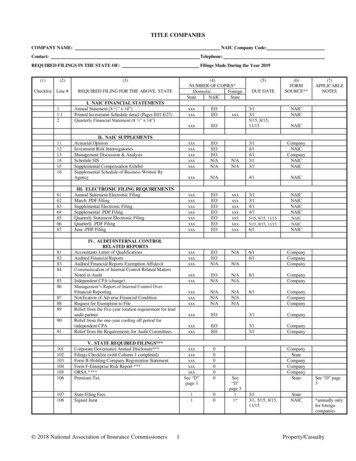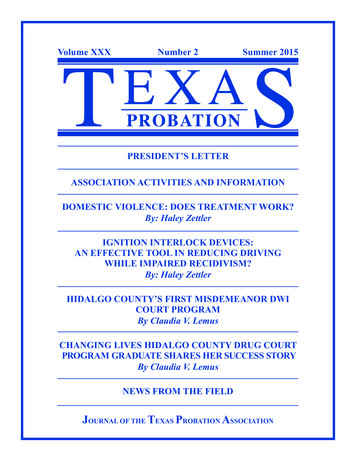
Transcription
Volume XXXNumber 2Summer 2015PRESIDENT’S LETTERASSOCIATION ACTIVITIES AND INFORMATIONDOMESTIC VIOLENCE: DOES TREATMENT WORK?By: Haley ZettlerIGNITION INTERLOCK DEVICES:AN EFFECTIVE TOOL IN REDUCING DRIVINGWHILE IMPAIRED RECIDIVISM?By: Haley ZettlerHIDALGO COUNTY’S FIRST MISDEMEANOR DWICOURT PROGRAMBy Claudia V. LemusCHANGING LIVES HIDALGO COUNTY DRUG COURTPROGRAM GRADUATE SHARES HER SUCCESS STORYBy Claudia V. LemusNEWS FROM THE FIELDJOURNAL OF THE TEXAS PROBATION ASSOCIATION
B oard of DirectorsTEXAS PROBATIONPresident:Caroline RickawayP.O. Box 1300Angleton, TX 77515979-864-2145Vice President:Chris Thomas121 North Austin Rm 301Jasper, TX 75951409-224-7151Volume XXXTreasurer:Roxane MarekP.O. Box 786Wharton, TX 77488979-532-7474SecretaryKarma Chambless2200 7th StreetBay City, TX 77414979-245-6512Parliamentarian:Ed Cockrell5326 Hwy 69 SouthBeaumont, TX 77705409-722-7474Juvenile Discipline:Lisa Tomlinson1102 East KilpatrickCleburne, TX 76031817-556-6880At Large:Randy Turner2701 Kimbo RdFort Worth, TX 76111817-838-4600Adult Discipline:Arnold K. PatrickP.O. Box 970Edinburg, TX 78540956-587-6000Juvenile Discipline:Iris Bonner-Lewis1200 CongressHouston, TX 77002713-394-4340At Large:Dan Collins2613 N. Guadalupe St.Seguin, TX 78155830-303-1274Adult Discipline:Steve Henderson701 Main StreetLubbock, TX 79401806-755-1200Juvenile Discipline:Edeska Barnes Jr.121 North Austin A101Jasper, TX 75951409-384-9063Number 2Summer 2015CONTENTSPRESIDENT’S LETTER . 1ASSOCIATION ACTIVITIES. 2ARTICLESDomestic Violence: Does Treatment Work?By: Haley Zettler. .5Ignition Interlock Devices:An Effective Tool in Reducing Driving While Impaired Recidivism?By: Haley Zettler .8Hidalgo County’s First Misdemeanor DWI Court ProgramBy Claudia V. Lemus . 11Changing LivesHidalgo County Drug Court Program Graduate Shares Her Success StoryBy Claudia V. Lemus . 12NEW MEMBERS. 13NEWS FROM THE FIELD . 14PROFESSIONAL PROFILES . 14At Large:Billie Jean BramP.O. Box 3038Wharton, TX 77488979-532-2465Adult Discipline:Bradley Wilburn114 Hurst St.Center, TX 75935936-591-4171Secretariat:Tiaya EllisSam Houston State UniversityHuntsville, TX 77341936-294-3073Alumni Board Member:Acie Berry512-635-3088Texas Probation is published quarterly (Winter, Spring, Summer and Fall) by Sam HoustonPress and Copy Center in Huntsville, Texas, for the Texas Probation Association. The contentsof articles or other materials contained in Texas Probation do not reflect the endorsements,official attitudes, or positions of the Texas Probation Association or the George J. Beto CriminalJustice Center at Sam Houston State University unless so stated. Articles may be reproducedwithout charge as long as permission is obtained from the editor and credit is given to boththe author and Texas Probation.
Volume XXX, No. 2TEXAS PROBATIONPRESIDENT’S MESSAGEWelcome to the summer issue of Texas Probation.I want to thank you for selecting me as yourTexas Probation Association President. I’mhonored to represent such a remarkable groupof professionals. My thanks are also extendedto outgoing President Ed Cockrell, a mentor andfriend to me now and during his term.Looking back, the 2015 Annual Conferencein Austin was a success with informative sessionsand interesting speakers. I’d like to thank the 2015Annual Conference Planning Committee CoChairs, A. C. Berry, Jr., Williamson County JPD(retired); Delana Lemley, Travis County CSCD;and Reuben Rabsatt, Bell County CSCD for theirdedication and initiative in planning and preparingfor the conference.A common theme evident in today’s research isthat relationships matter. In this “high tech” world,reaching out to colleagues, defendants, and clientsis important. Learning to communicate effectivelyand establish quality relationships can have apositive effect on the delivery of communitysupervision services. One of the articles in thisjournal describes the success story of a HidalgoCounty Drug Court Program graduate. This storydemonstrates the impact of the probation officer infacilitating positive change for this graduate.As we continue to attempt implementationof evidence-informed approaches in communitysupervision, the review and presentation of currentresearch is essential for us to make decisionswhich will improve outcomes. Two articles inthis journal analyze the available research on (1)the effectiveness of ignition interlock devicesand (2) the significance of treatment in domesticviolence programs. The questions raised by thecritical analysis of these bodies of research canassist in framing future research and qualify theapplication of these tools and practices.In closing, I want to thank the Co-Editors ofthe Publications Committee, Billie Jean Bram,Wharton County JPD; and Karla Kutch, BrazoriaCounty CSCD, for their commitment, diligence,and time in preparing Texas Probation forpublication. Please consider contributing an articlefor publication or information for “News Fromthe Field”. We also welcome your feedback aboutyour journal. By learning from each other, we willstrengthen our collective mission of providingeffective services and enhancing public safety.I hope everyone is enjoying their summerand looking forward to the 2015 LegislativeConference in Houston in August. This willbe an excellent opportunity to celebrate ouraccomplishments and learn about the latestdevelopments in the field.Caroline RickawayTPA President1
2TEXAS PROBATIONVolume XXX, No.2ASSOCIATION ACTIVITIES AND INFORMATION2015 TPA Annual ConferenceWe had a great time in Austin! Hope to see you at the upcoming conferences!
Volume XXX, No. 2TEXAS PROBATIONTPA AWARD RECIPIENTSCharles W. Hawkes Lifetime Achievement Award:—Toby Ross, Johnson County CSCD (Retired)Brian J. Kelly Award (Adult Administrator):—Marcy Anthony, Angelina County CSCDJudge Terry L. Jacks Award (Adult Officer):—Will Hurley, Wharton/Matagorda CSCDAmador R. Rodriguez Award (JuvenileAdministrator):—LaRonda Turner, Jefferson County JPDClara Pope Willoughby Award (Juvenile Officer):—Amber Sellers, Tom Green JPDLewis “Butch” Amonette Award:—Jason Hickman, Jasper, Newton, Sabine and SanAugustine County CSCDRoy H. Williams, Sr. Award:—Karma Chambless, Wharton/Matagorda CSCDUPCOMING CONFERENCES2016 Annual ConferenceApril 17-20, 2016Embassy Suites – San Marcos2016 Legislative ConferenceAugust 14-17, 2016Embassy Suites - Frisco2017 Annual ConferenceApril 2017Austin – Southpark Omni3
Volume XXX, No. 2TEXAS PROBATIONELECTION RESULTSPRESIDENT—Caroline Rickaway, Brazoria County CSCDVICE PRESIDENT—Christopher B. Thomas, Jasper, Newton, Sabine & San Augustine Counties CSCDTREASURER—Roxane B. Marek, Wharton & Matagorda County CSCDJUVENILE—Edeska Barnes, Jasper, Newton, Sabine & San Augustine County Juvenile ProbationADULT—Bradley Wilburn, Panola/Shelby Counties CSCDAT LARGE—Billie Jean Bram, Wharton County Juvenile Probation DepartmentIN MEMORIAMR. Allison JoyceR. Allison Joyce, the long-time director of the Bell/Lampasas Counties Community Supervision andCorrections Department passed away on October 25,2014. Allison Joyce served as the director of the Bell/Lampasas Counties CSCD from 1978 to 1997. Thiswas a transitional period in community correctionsin the State. During Mr. Joyce’s tenure as director,he saw the creation of the Texas Adult ProbationCommission, the transfer of authority over an adultprobation department from the county to the DistrictJudges, the great reforms in community correctionsin 1989, the consolidation of the state prison, paroleand probation system, the establishment of SubstanceAbuse Felony Punishment Facilities, and the creationof state jail felony offenses and state jail felonyfacilities. Despite all of these changes and challenges,Mr. Joyce successfully steered the Bell/LampasasCounties CSCD through a sometimes tumultuousperiod in community corrections.Allison Joyce was a man of enduring faith. Heearned his B. A. at Southwest Texas State Teachers in1957 and was awarded a Master of Divinity degree atBrice Divinity School at Texas Christian Universityin 1963. Prior to becoming the director of the Bell/Lampasas Counties CSCD, he served as the ministerof several Christian Churches, Disciples of Christin the Central Texas area. He also served as theRegional Alcohol Services Director for the CentralTexas Council on Alcoholism. He had a deep passionin the treatment of alcohol and substance abuse andwas instrumental in establishing several treatmentoptions in Bell and Lampasas Counties. After hisretirement from the Bell/Lampasas Counties CSCD,he devoted his time to volunteering at the MountainView Maximum Women’s Prison Unit in Gatesville,performing marital counselling, and serving as theminister of the Christian Community Church inBuckholts, Texas.Because of Allison Joyce’s dedication to the field ofcommunity corrections and in recognition of his deepfaith, the Texas Probation Association establishedthe Allison Joyce Prayer Breakfast held at each of itsconferences. The prayer breakfast will henceforth benamed the Allison Joyce Memorial Prayer Breakfast.Allison Joyce is survived by his wife of 54 years, Lola,two sons and a daughter, and several grandchildrenand great-grandchildren. Several of the officers hehired are still with the Bell/Lampasas CountiesCSCD. He served as a mentor to many of the staffof the CSCD and will be sorely missed by those whoknew and worked with him.4
TEXAS PROBATIONVolume XXX, No. 25ARTICLESDomestic Violence: Does Treatment Work?By: Haley ZettlerHaley Zettler is a third year PhD student in University of Texas at Dallas’s Criminologyprogram. She received her Bachelor’s in Criminology from the University of Oklahoma andher Master’s in Criminal Justice from the University of North Texas. Her primary researchinterests include community corrections, pretrial release, corrections, and program evaluation. She is a former Adult Probation Officer and has several years’ experience supervisingprobationers, conducting pretrial sentence investigations, and serving as a court officer.She currently teaches at the University of Texas at Dallas and is a research assistant for theCenter for Crime and Justice Studies.IntroductionHistorically little attention was given to domesticviolence and the subsequent behavior of batterers. Withthe passage of the 1994 Violence Against Women Act,awareness was given to the problem of domestic violenceprompting improvements in both criminal justice andcommunity responses (Reckendwald and Parker, 2012). Itis estimated that one in four women will become a victimof domestic abuse sometime in their life time (NationalInstitute of Justice, 1999). This staggering statistic hasencouraged both criminal justice officials and the publicto demand responses to these offenders.The sanctions imposed on domestic violence offendersvary, ranging from incarceration, enforcing protectiveorders, court ordered probation, and treatment. Of theseresponses, there has been a drastic increase in the useof court-ordered treatment. Since these offenders haveassaulted someone that they are intimately involved with,it is important to understand the nature of their actions andprevent further acts of violence. One recent estimate placesthe proportion of court-mandated treatment programs fordomestic violence at eighty percent (Healey et al., 1997).While treatment has become widely used for domesticviolence offenders, it is important to evaluate the efficacyof these programs. This paper provides a review of theliterature evaluating the effectiveness of court-ordereddomestic violence treatment and its impact on preventingrecidivism.Support for Court-MandatedDomestic Violence TreatmentWith the increased use of court-ordered treatment foroffenders convicted of domestic violence, researchershave conducted numerous studies evaluating particularprograms and their effects on reducing further violence andreoffending. Many of these studies have found support fortreatment reducing recidivism.One evaluation of several studies found consistentsupport for treatment reducing recidivism (Davis and Taylor,1999). An experimental evaluation compared a group ofoffenders who were assigned forty hours of communityservice to a group that were assigned forty hours of abatterer’s treatment program (Taylor et al., 2001). Theresults of the study found significantly lower official recordrecidivism rates for the group who received treatment aswell as lower victim self-reports of further violence (Tayloret al., 2001). Similarly, Hendricks and colleagues (2006)found significantly lower rates of recidivism for offenderswho completed treatment. This reduced recidivism byabout twenty eight percent. Another study comparedthirty different batterers’ intervention programs and founda reduction in recidivism ranging between thirty-nineand sixty-one percent (Bennett et al., 2007). Coulter andVandeWeerd (2009) also found support for the hypothesisthat treatment can reduce recidivism for all types of criminaloffending not only further domestic assaults. Another studyfound that the completion of all treatment sessions is alsorelated to lower recidivism rates (Gordon and Moriarty,2003). These findings support the notion that treatment canreduce recidivism.There have been a number of studies that examine thelong-term effects of treatment on recidivism. One studyfollowed offenders for two years, comparing men that wereincarcerated to those who participated in court-orderedtreatment (Babcock and Steiner, 1999). Babock and Steiner(1999) found that those who attended treatment had lowerrecidivism rates after two years and those who were
TEXAS PROBATION6incarcerated had the highest rates of reoffending. Anotherlengthy study followed offenders eleven years after theirintervention and found a significantly lower recidivism ratiofor those offenders who completed treatment when theywere compared to those offenders who did not completetreatment (Dutton et al., 1997). These long-term studiesshow promising results, suggesting that there can be longterm benefits to mandating treatment for domestic violenceoffenders.Failure to Find Support forDomestic Violence TreatmentAlthough there is a body of literature that lends supportfor domestic violence treatment reducing recidivism,there are also a number of studies that do not. One studycomparing multiple sites of treatment in four cities foundno significant difference in re-assault rate, portion of menmaking threats, and the victims’ quality of life (Gondolf,1999). However, this study did find that those who completedtreatment had lower rates of severe re-assaults (Gondolf,1999). Another study by Jackson and colleagues (2003)found that a great number of men dropped out of treatmentprior to completion and there was no significant differencein the re-offending rate or their attitudes about domesticviolence. Likewise, an additional study followed eightysix men after completion of a domestic violence treatmentprogram and found no significant reduction in re-offending(Bowen et al., 2005). These studies cast doubt on theargument that treatment programs reduce domestic violencerecidivism in a significant way.There are several studies that find mixed support for howtreatment affects recidivism. A meta-analysis reviewingtwenty-two studies found overall effects due to treatmentwere small in range, and only have a minimal impact onreducing recidivism beyond the effect of being re-arrested(Babcock et al., 2004). One study attempts to explain whythese discrepancies in effectiveness may exist (Sartin etal., 2006). Sartin and colleagues argue that it is difficult tomeasure effectiveness since many studies rely primarily onlegal records, while others focus on convictions as evidenceof recidivism; and still others use victim self-report data.Since these studies often employ different ways to measurerecidivism, it is often difficult to compare results acrossstudies.Factors Related to Reducing Recidivismwith Domestic Violence TreatmentSome research has focused on the factors related tosuccessful completion of domestic violence treatment aswell as prevention of future offending. Shepard (1992)conducted a follow up five years after treatment and foundthose men who had been abusive for a shorter duration,Volume XXX, No.2who were court ordered to have a chemical dependencyevaluation, in chemical dependency treatment, abused aschildren, or previously convicted for non-assault crimeswere more likely to recidivate. Similarly, Tollefsonand Gross (2006) found four predictors of recidivism:psychopathology, psychiatric history, substance abuse, andchild abuse. The study found that these four factors couldpredict eighty-four percent of all outcomes of recidivism(Tollefson and Gross, 2006). Another study looked atthe psychological effects of treatment, predicting thatparticipants would be more truthful, less violent, and haveincreased coping abilities (Buttell and Carney, 2004). Theresults failed to provide support that after twelve months oftreatment the participants demonstrated significant changesin the direction of these psychological variables related torecidivism (Buttell and Carney, 2004).Additionally, one study looked at the factors that explainattrition in domestic violence treatment programs. Jewell andWormith (2010) conducted a meta-analysis examining thefactors that are related to failure to complete court orderedtreatment programs and found that several variables wererelated to completing treatment; these include employment,age, income, education, marital status, race, referral source,previous domestic violence offenses, criminal history, andalcohol and drug use (Jewell and Wormith, 2010). It isimportant to consider these factors when placing an offenderin a treatment program to better ensure completion andprevent further offending.ConclusionsAs domestic violence and abusive offenders become agrowing concern, it is important to understand what worksin preventing further abuse and offending when they areno longer under the court’s supervision. Domestic violencetreatment is now an ordinary part of the offenders’ sentence.The research suggests there is promise to these programs,as many have found empirical support that treatment worksto reduce recidivism. Although there is some evidencethat there may not be a significant effect, taking intoconsideration other risk factors for reoffending should beaddressed and could potentially increase the overall successrate of these programs.One limitation of the research reviewed is the majority ofthe evaluations and studies focus solely on a male offendingpopulation. However, the National Family Violence Survey(2000) found nearly equal assault rates by an intimate partnerfor women and men. Future research should consider femaleoffenders in their evaluations and compare recidivism ratesto see if treatment is equally effective for male and femaleoffenders. It is plausible that treatment affects the groupsdifferently and risk factors may also differ between groups.
TEXAS PROBATIONVolume XXX, No. 2ReferencesBabcock, J.C., Green, C.E., and Robie, C. (2004). Does Batterer’sTreatment Work? A Meta-analytic Review of Domestic Violence Treatment. Clinical Psychology Review, 1023-1053.Babcock, J.C., and Steiner, R. (1999). The Relationship BetweenTreatment, Incarceration, and Recidivism of Battering: AProgram Evaluation of Seattle’s Coordinated CommunityResponse to Domestic Violence. Journal of Family Psychology, 13:1, 46-59.Bennett, L.W., Stoops, C., Call, C., and Flett, H. ProgramCompletion and Re-Arrest in a Batterer Intervention System.Research on Social Work Practice, 17:1, 42-54.Bowen, E., Gilchrist, E.A., and Beech, A.R. (2005). An Examination of the Impact of Community-Based Rehabilitation on theOffending Behaviour of Male Domestic Violence Offendersand the Characteristics Associated with Recidivism. Legaland Criminological Psychology, 10, 189-209.7Healey, K., Smith, C., and O’Sullivan, C. (1997) Batterer Intervention: Program Approaches and Criminal Justice Strategies.National Institute of Justice.Hendricks, B., Werner, T., Shipway L., and Turinetti, G.J. (2006).Recidivism Among Spousal Abusers: Predictions and Program Evaluation. Journal of Interpersonal Violence, 21: 703.Jackson, S., Feder, L., Forde, D.R., Davis, R.C., Maxwell, C.D.,and Taylor, B.G. (2003). Batterer Intervention Programs:Where Do We Go From Here? National Institutes of JusticeReport.Jewell, L.M., and Wormith, J.S. (2010). Variables Associatedwith Attrition from Domestic Violence Treatment ProgramsTargeting Male Batterers: A Meta-Analysis. Criminal Justiceand Behavior, 37: 1086.National Institute of Justice. (2000). Extent, Nature, and Consequences of Intimate Partner Violence: Findings from theNational Violence Against Women SurveyButtell, F.P., and Carney, M.M. (2004). A MultidimensionalAssessment of a Batterer Treatment Program: An Alert to aProblem? Research on Social Work, 14:2, 93-101.Reckenwald, A., and Parker, K.F. (2012). Understanding theChange in Male and Female Intimate Partner Homicide OverTime: A Policy-and Theory-Relevant Investigation. FeministCriminology, 7: 167.Coulter, M., and VandeWeerd, C. (2009). Reducing DomesticViolence and Other Criminal Recidivism: Effectiveness ofa Multilevel Batterers Intervention Program. Violence andVictims, 24: 139-152.Sartin, R.M., Hansen, D.J., and Huss, M.T. (2006). DomesticViolence Treatment Response and Recidivism: A Review andImplications for the Study of Family Violence. Aggressionand Violent Behavior, 425-440.Davis, R.C., and Taylor, B.G. (1999). Does Batterer TreatmentReduce Violence? Women and Criminal Justice, 10:2, 69-93.Shepard, Melanie. (1992). Predicting Batterer Recidivism FiveYears after Community Intervention. Journal of FamilyViolence, 7:3.Gondolf, E.W. (1999). A Comparison of Four Batterer InterventionSystems: Do Court Referral, Program Length, and ServicesMatter? Journal of Interpersonal Violence, 14:1, 41-61.Gordon, J.A., and Moriarty, L.J. (2003). The Effects of Domestic Violence Batterer Treatment on Domestic ViolenceRecidivism: The Chesterfield Experience. Criminal Justiceand Behavior, 30: 118.Taylor, B.G., Davis, R. C., and Maxwell, C.D. (2001). The Effects of a Group Batterer Treatment Program: A RandomizedExperiment in Brooklyn. Justice Quarterly, 18:1, 171-201.Tollefson, D.R., and Gross, E.R. (2006). Predicting RecidivismFollowing Participation in a Treatment Program for Batterers.Journal of Social Service Research, 32:4, 39-62.
8TEXAS PROBATIONVolume XXX, No.2Ignition Interlock Devices:An Effective Tool in Reducing Driving While Impaired Recidivism?By: Haley ZettlerThe social phenomenon of drinking and driving hasgrabbed the attention of not only the criminal justice realm,but the general public as well. There has been a renewedfocus devoted to making our streets safer and preventingdrinking and driving. One alarming statistic demonstratesthat approximately one-third of all drivers convicted of adriving while impaired offense are repeat offenders (Fell,1995). As such, policies have been put in place to reducerecidivism. Among these policies is the development ofignition interlock devices, which prevent the driver fromstarting their vehicle if alcohol is detected, thus preventingdrunk driving. This review summarizes the literature thatexamines the effect of ignition interlock devices on reducingrecidivism rates of impaired driving.Effects on First Time Offenders and Repeat OffendersSince preventing continued drinking and drivingoffenses is a focal concern, it is important to distinguish forwhom the ignition interlock device is most effective. Someresearch has compared the effects of the ignition interlockon first time offenders against repeat offenders. Voas andcolleagues (1999) compared recidivism rates for both firsttime offenders and second time offenders and found thatfor both groups, recidivism was reduced while the ignitioninterlock was installed. Similarly, Willis and colleagues(2004) found that while the ignition interlock was installed,recidivism rates for both first time and repeat offenderswere lower than the control groups. Likewise, Roth andMarques (2007) found that first time offenders with theignition interlock installed recidivated at a lower rate thanthe control group.In contrast, Fulkerson and colleagues (2003) examinedthree-year recidivism rates for first time offenders andrepeat offenders, and found that repeat offenders who hadthe ignition interlock installed had significantly lower rearrest rates, whereas there was virtually no difference forfirst time offender rates.When comparing the use of interlock device to othersanctions imposed, Ahlin and colleagues (2011) lookedsolely at the effects on first time offenders. The results ofthe study found that no matter how first time offenderswere sanctioned, they were still at a substantial risk ofrecidivism (Ahlin et al., 2011). These findings suggest thatignition interlock devices may not be as effective on firsttime offenders.Roth and Marques (2007) assessed the effect of ignitioninterlocks on repeat offenders. Comparing second and thirdtime offenders, the study found a significant reduction whilethe ignition interlock was installed (Roth and Marques,2007). In a somewhat different approach, Marques andcolleagues (2001) looked at the failure rates of those whohad the ignition interlock device installed and found thatthose with greater failure rates coupled with prior offenseswere most likely to recidivate.These findings suggest there may be different effectsfor first time offenders as compared to repeat offenders. Itis difficult to measure the direct impact that the ignitioninterlock may have on these disparities, since repeatoffenders are often punished more severely with additionalsanctions.Effects during the Installation Periodand the Removal PeriodConsidering the logic behind the ignition interlock deviceis to deter offenders from continuing to drink and drive,it is important to measure the long-term effects. The vastmajority of the research supports the argument that ignitioninterlock devices reduce recidivism while the device isinstalled on the vehicle, but the effects diminish once thedevice is removed.Some of the research has focused only on the effects thatthe ignition interlock may have while the device is installed.Morse and Elliott (1992) compared offenders whose licenseswere suspended as a result of their conviction to those whowere sanctioned with the ignition interlock device. Theresearch found that the re-arrest rate was significantly lower
Volume XXX, No. 2TEXAS PROBATIONwhile the device was installed when compared to the controlgroup (Morse and Elliott, 1992). Similarly, Weinrath (1997)found that ignition interlock participants were roughlyfour times less likely to be rearrested than a group that didnot have the device installed. Bjerre and Thorsson (2008)compared those who voluntarily installed an interlockdevice compared to a group that chose license revocation.Bjerre and Thorsson (2008) found that the ignition interlockgroup not only had lower driving while impaired recidivismrates by about sixty percent, but also reported lower levelsof harmful alcohol consumption.Coben and Larkin (1999) examined six prior studies toevaluate the effectiveness of ignition interlock devices onrecidivism. The evaluation found that five of the six studiesresulted in a reduction in the arrest rate for the ignitioninterlock group ranging from between fifteen and sixtynine percent (Coben and Larkin, 1999). Coben and Larkin(1999) also reviewed one randomized trial, and found aconsiderable reduction in arrests for the group with theignition interlock installed.Although there is overwhelming support for theeffectiveness of ignition interlock devices in reducingrecidivism while installed, the body of research that hasexamined the long-term effects found waning effects oncethe device is removed.Beck and colleagues (1999) examined offenders whowere randomly assigned to ignition interlock programscompared to those who were assigned to traditional licenserestriction programs during a one year treatment periodand a one year post-treatment period. The study found thatduring the ignition interlock installation period, recidivismwas reduced by sixty-five percent (Beck et al., 1999).However, the research found no significant differencesduring the one-year post-treatment period (Beck et al.,1999). Likewise, several other studies found no significantdifferences in recidivism rates once the ignition interlockwas removed (Voas et al., 1999; Roth et al,. 2007; Roth etal., 2007). These consistent findings raise concern over thelong-term effects of the ignition interlock device.Raub and colleagues (2003) looked at the long-term effectof ignition interlocks on repeat offenders. The researchfound that the group with the ignition interlock installedwas one-fifth as likely to be rearrested during the one-yearinstallation period (Raub, et al., 2003). However, during thepost-intervention period, rearrest rates increased to ratessimilar to those that did not have the ignition interlockinstalled (
and probation system, the establishment of Substance Abuse Felony Punishment Facilities, and the creation of state jail felony offenses and state jail felony facilities. Despite all of these changes and challenges, Mr. Joyce successfully steered the Bell/Lampasas Counties CSCD through a sometimes tumultuous period in community corrections.


